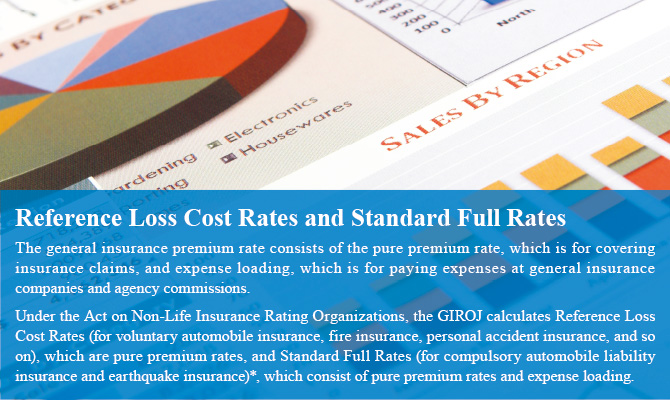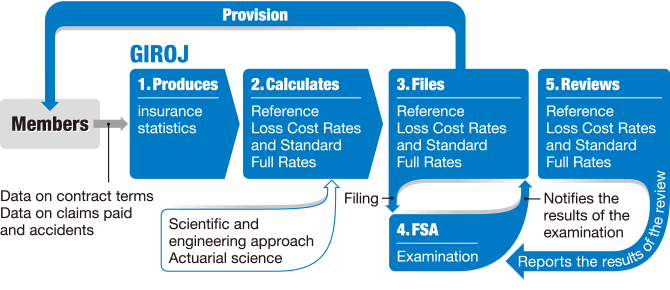Ratemaking
1. Calculation and Provision of Reference Loss Cost Rates and Standard Full Rates
GIROJ produces accurate insurance statistics by compiling large volumes of data reported primarily by its members.
Based on these statistics, GIROJ calculates Reference Loss Cost Rates and Standard Full Rates, using rational techniques, including a scientific and engineering approach and actuarial science, and provides the rates to its members.
Calculation of rates using large quantities of data
Rates are calculated based on reliable, high-quality insurance statistics that GIROJ produces by processing large volumes of data reported primarily by its members, taking into consideration the differences among members’ products.
The Reference Loss Cost Rates and Standard Full Rates, which are calculated based on these insurance statistics, are beneficial for members as well as policyholders.
Development of risk models in cooperation with experts
GIROJ has developed natural hazard risk models for typhoons, floods, and earthquakes, and calculates rates using a scientific and engineering approach.
The risk models are rational and backed by the outcomes of continuous joint academic research in a study group comprising experts in meteorology, seismology and architecture, as well as by historical insurance data.


2. Types of GIROJ’s Rates
(1) Reference Loss Cost Rates
A. Voluntary Automobile insurance
- Bodily injury liability coverage
- Self-incurred personal accident coverage
- Protection against uninsured automobile
- Property damage liability coverage
- Bodily injury indemnity coverage
- Physical damage coverage
B. Fire insurance
- Dwelling Risk (Fire insurance and comprehensive insurance for housing)
- General Risk (Fire insurance and comprehensive insurance for office buildings, retail properties, etc.)
- Factory Risk (Fire insurance for factories)
- Warehouse Risk (Fire insurance for commercial warehouses)
C. Personal accident insurance
- Ordinary personal accident insurance
- Family type personal accident insurance
- Traffic personal accident insurance
- Family type traffic personal accident insurance
- Domestic travelers’ personal accident insurance
- Overseas travelers’ personal accident insurance
(2) Standard Full Rates
A. Compulsory automobile liability insurance
B. Earthquake insurance
3. Workflow of Calculation and Provision of Rates

 GIROJ produces insurance statistics based on large quantities of data reported by its members.
GIROJ produces insurance statistics based on large quantities of data reported by its members.
 GIROJ calculates rates using the insurance statistics produced.
GIROJ calculates rates using the insurance statistics produced.
GIROJ calculates rates using a statistical method based on historical data for types of insurance for which sufficient contract data and payment data can be obtained (voluntary automobile insurance, CALI, personal accident insurance).
In addition to the statistical method, GIROJ uses an engineering approach based on natural hazard risk models* for fire insurance that covers natural disasters (windstorms, floods and earthquakes among others) for which the frequency of payments is low and sufficient data cannot be obtained.
 GIROJ files the calculated rates with the Commissioner of the FSA and provides them to members promptly.
GIROJ files the calculated rates with the Commissioner of the FSA and provides them to members promptly.
GIROJ makes a public announcement of Standard Full Rates and necessary matters.
 When accepting the filing of Reference Loss Cost Rates or Standard Full Rates, the Commissioner of the FSA examines whether the rates comply with the three principles of premium rates under the Act on Non-Life Insurance Rating Organizations (in addition, the principle of no loss and no profit for Standard Full Rates for CALI)**.
When accepting the filing of Reference Loss Cost Rates or Standard Full Rates, the Commissioner of the FSA examines whether the rates comply with the three principles of premium rates under the Act on Non-Life Insurance Rating Organizations (in addition, the principle of no loss and no profit for Standard Full Rates for CALI)**.
After the FSA’s examination, GIROJ informs members of the rates promptly so that they can calculate their own premium rates based on the Reference Loss Cost Rates or Standard Full Rates.
 It may turn out that the Reference Loss Cost Rates and Standard Full Rates have deviated from the actual risks due to changes in social environment and other reasons.
It may turn out that the Reference Loss Cost Rates and Standard Full Rates have deviated from the actual risks due to changes in social environment and other reasons.
In order to maintain the rates at an appropriate level, GIROJ verifies the rates every year, reports the results of the verification to the Commissioner of the FSA, and also revises the rates when it is deemed necessary based on the results



